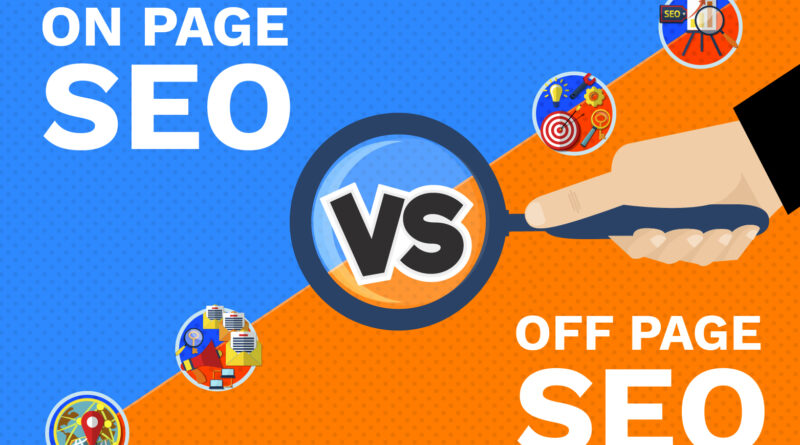On-Site SEO vs Off-Site SEO: Key Differences and Optimization Strategies
When it comes to improving a website’s visibility on search engines, on-site SEO and off-site SEO are two fundamental strategies that work together to enhance overall performance. Understanding the differences between these two types of SEO and how to optimize them effectively is crucial for anyone looking to boost their online presence. This article delves into the key differences between on-site SEO and off-site SEO, and offers actionable strategies for optimization.
What is On-Site SEO?
On-site SEO refers to the practices and techniques applied directly on your website to improve its search engine ranking and enhance user experience. This type of SEO focuses on optimizing individual pages to make them more relevant and accessible to both search engines and users.
Key Elements of On-Site SEO
- Keyword Optimization: Incorporating relevant keywords into your website’s content, headings, meta descriptions, and URLs is fundamental for on-site SEO. This helps search engines understand what your pages are about and match them with relevant search queries.
- Content Quality: High-quality, engaging, and original content is crucial for on-site SEO. Search engines favour content that provides value to users, so focus on creating informative articles, blog posts, and resources that address user needs.
- Title Tags and Meta Descriptions: These HTML elements provide a summary of your page’s content. optimizing title tags and meta descriptions with relevant keywords helps improve click-through rates and search engine rankings.
- Internal Linking: Linking to other pages within your site helps search engines crawl and index your content more effectively. It also keeps users engaged by providing them with additional relevant information.
- Page Speed and Mobile Friendliness: A fast-loading website and a responsive design are essential for good user experience and on-site SEO. Search engines prioritise sites that load quickly and are mobile-friendly.
- URL Structure: Clean, descriptive URLs that include relevant keywords improve both user experience and search engine indexing. Avoid complex or lengthy URLs.
What is Off-Site SEO?
Off-site SEO, on the other hand, involves strategies and actions taken outside of your website to improve its authority and credibility. The primary focus of off-site SEO is to build a positive reputation and increase the number of quality backlinks pointing to your site.
Key Elements of Off-Site SEO
- Backlink Building: Acquiring high-quality backlinks from reputable websites is a cornerstone of off-site SEO. These links act as endorsements of your site’s content and contribute to higher search engine rankings.
- Social Media Engagement: Active participation on social media platforms helps increase brand visibility and drive traffic to your website. Social signals, such as likes, shares, and comments, can indirectly impact SEO.
- Online Reputation Management: Managing your online reputation through reviews and ratings on platforms like Google My Business and Yelp can enhance credibility and attract more visitors.
- Influencer Marketing: Collaborating with influencers or industry experts can generate quality backlinks and increase your website’s exposure to a broader audience.
- Content Marketing: Publishing guest posts, articles, and press releases on reputable external sites can help build backlinks and establish authority in your niche.
- Local SEO: For businesses with a physical presence, local SEO strategies such as listing on Google My Business and local directories play a significant role in off-site SEO.
Key Differences Between On-Site SEO and Off-Site SEO
- Focus and Implementation:
- On-Site SEO: Focuses on elements within your website. It involves direct optimization of content, structure, and technical aspects.
- Off-Site SEO: Focuses on external factors such as backlinks and social signals. It involves actions taken outside your website to boost its authority and reputation.
- Control and Measurement:
- On-Site SEO: Offers more control over the optimization process. You can directly implement changes and measure their impact through analytics.
- Off-Site SEO: Involves efforts outside your control, such as earning backlinks from other sites. Measurement relies on monitoring referral traffic and backlink quality.
- Impact on User Experience:
- On-Site SEO: Directly affects user experience through content quality, site speed, and navigation. It aims to make your site more user-friendly and relevant.
- Off-Site SEO: Indirectly affects user experience by improving site credibility and attracting more traffic through external endorsements.
Optimization Strategies for On-Site SEO and Off-Site SEO
- For On-Site SEO:
- Conduct keyword research to identify the most relevant terms for your audience.
- Regularly update and optimize your content to keep it fresh and relevant.
- Improve page speed by compressing images and minimising code.
- Ensure your site is mobile-friendly and has a responsive design.
- For Off-Site SEO:
- Build relationships with reputable websites to earn high-quality backlinks.
- Engage with your audience on social media and encourage sharing of your content.
- Monitor and manage your online reputation through reviews and feedback.
- Leverage content marketing by publishing guest posts and press releases.
Conclusion
Both on-site SEO and off-site SEO play crucial roles in improving a website’s search engine ranking and overall online presence. While on-site SEO focuses on optimizing elements within your website to enhance relevance and user experience, off-site SEO involves strategies that build your site’s authority and credibility through external channels. By effectively implementing and balancing both types of SEO, you can achieve better visibility, attract more traffic, and drive growth for your online business.




